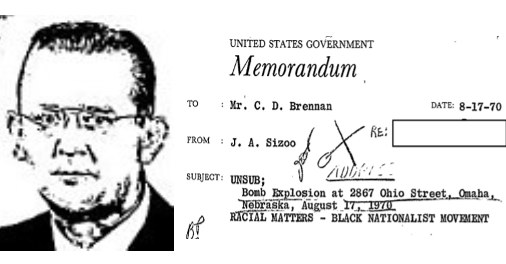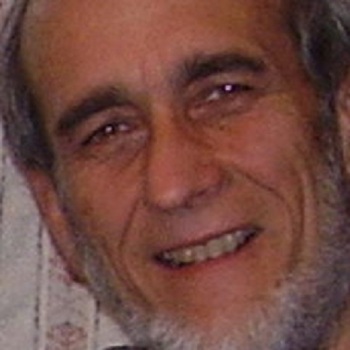
On August 17, 1970, at 2:07 a.m., Omaha police received a 911 emergency telephone call from a male who spoke in a deep gravely voice that a woman was screaming at 2867 Ohio Street, a vacant house. Eight policemen responded. While officers searched a tremendous, blinding flash and deafening blast shook the silent neighborhood and ripped through the walls of the vacant house killing Patrolman Larry Minard.
Two men, Edward Poindexter and David Rice (later Wopashitwe Mondo Eyen we Langa), leaders of the Black Panther affiliate National Committee to Combat Fascism were targets of the Federal Bureau of Investigation at the time of the murder and were to be blamed for the crime.
A call was made to FBI headquarters in Washington from the Omaha office at 6:45 a.m. Charles Brennan, Assistant Directer, was informed by memorandum about the call concerning the death of a policeman.
“Omaha Office offered assistance in covering out-of-state leads and FBI Laboratory facilities offered. Omaha advised it had notified military and Secret Service, was following closely, and alerted its racial informants in pursuit of investigation.”
Brennan was also assured, “Pertinent parts will be included in teletype summary to the White House, Vice President, Attorney General, military and Secret Service.”
One of Brennan’s priority duties as head of the Domestic Intelligence Division, which he aggressively pursued, was directing counterintelligence operations under the clandestine COINTELPRO program. Brennan had only been in his new command post for two weeks and was determined to break the Black Panther Party which J. Edgar Hoover had declared was the number one threat to domestic security.
FBI censors have kept the public from learning if Brennan ordered Special Agent in Charge Paul Young to use the bombing to frame Black Panther leadership or if Young first proposed the subterfuge. In any event, Young did make arrangements for the recording of the 911 call that lured Minard to his death to be sent to the FBI Laboratory where a formal would be withheld, eliminating crucial evidence from the homicide investigation. Young wrote the same day to Hoover explaining his actions.
Brennan stayed in the loop with letters and calls from Young to FBI headquarters keeping Brennan updated on the case. Two internal memorandums from William Bradley, a supervisor, detailed the plan to withhold a laboratory report on the 911 recording.
“Omaha Office has advised that the Omaha Police Department has requested laboratory assistance in connection with a bombing which took place in Omaha 8/17/70. This bombing resulted in the death of one police officer and the injuring of six other officers and is apparently directly connected with a series of racial bombings which the Omaha Police have experienced. The Police were lured to the bomb site by a telephonic distress call from an unknown male.”
“If approved, the results of any examinations will be orally furnished the Police on an informal basis through the SAC, Omaha.”
Charles Brennan, only on the job several weeks as Assistant Director in charge of the FBI Domestic Intelligence Division, was on a special typed distribution list. A second Bradley memo, confirming the first, also includes Brennan and bears his initials of approval. Young’s plan, approved by Brennan, worked and the jury that convicted Poindexer and Mondo never heard the killer’s voice on the 911 recording, a voice that belonged to neither man.
Before his death in prison in March 2016, Mondo commented on the memos. “This is pretty clear indication of cloak and dagger stuff. We want you to do the analysis but we don’t want you to put the results in writing. Communicate to us this way. So I suspect that somewhere between that memo and the prior one, the decision was made that the tape would not be part of the trial. A vital issue, a critical issue.”
In March 1971, while pre-trial proceedings occupied Paul Young’s attention in Omaha, a burglary at the Media, Pennsylvania FBI office yielded hundreds of COINTELPRO documents and alarmed Charles Brennan who realized the danger of the secret memoranda becoming public information. By the time the verdict was announced in the Omaha trial clandestine documents had been delivered to multiple news outlets. Ten days after the Omaha trial ended, Brennan made a recommendation.
“To afford additional security to our sensitive techniques and operations, it is recommended the COINTELPROS operated by the Domestic Intelligence Division be discontinued.”
“These programs involve a variety of sensitive intelligence techniques and disruptive activities which are afforded close supervision at the Seat of Government. They have been carefully supervised with all actions being afforded prior Bureau approval and an effort has been made to avoid engaging in harassment. Although successful over the years, it is felt they should now be discontinued for security reasons because of their sensitivity.”
J. Edgar Hoover acted the next day and issued an order. “Effective immediately, all COINTELPROs operated by this Bureau are discontinued.”
After Brennan’s mentor, William Sullivan, lost a power struggle with Hoover for control of the Bureau Brennan was demoted to the Alexandria, Virginia FBI office. While there, Brennan was censured for releasing a FBI report on a policeman’s killer to local police. The censure followed an internal Bureau memorandum that discussed disclosure of FBI reports to local police and Brennan’s action.
“We should not permit the action by the SAC, Alexandria to go unchallenged, for to do so, would give tacit approval to field offices to disseminate FBI reports to their local departments. The potential scope of such dissemination is beyond estimation, since in nearly all of our criminal, local agencies have concurrent interests. If FBI reports were indiscriminately furnished to police departments, they could very possibly become parts of police records which are made available to members of the press, and there is no end to speculation as to what use could be made of information from such reports. It is also pointed out that FBI reports, if allowed to be given to police agencies, would be available to local prosecutors, many of who are politically oriented and would be very happy to quote FBI reports for whatever purpose best suited them.”
Brennan’s actions in Alexandria were a sharp contrast to Omaha, where Brennan approved withholding a report from local police on a policeman’s killer.
In January 1975, the United States Senate created the Select Committee to Study Governmental Operations which became known as the Church Committee after its chairman, Senator Frank Church. The Church Committee tackled investigation of the assassination of President John Kennedy, a myriad of abuses by the Central Intelligence Agency, Watergate misdeeds, and COINTELPRO crimes by the Federal Bureau of Investigation. Senator Church chaired the only serious Congressional inquiry into COINTELPRO, however the work stopped short when the Committee adjourned the following year after the public had become weary of unsavory disclosures.
Charles Brennan was questioned by Church Committee staff. A memorandum in Brennan’s FBI personnel file summarized his interview.
“Relative to the COINTELPRO, Brennan advised the Staff Members he couldn’t be very specific regarding COINTELPRO inasmuch as he did not pay too much attention to it. They questioned him about this statement and Brennan stated that when you would compare COINTELPRO to such activities as the Bay of Pigs and the Glomar Explorer, COINTELPRO was “peanuts.” Brennan was asked why he didn’t recommend COINTELPRO be discontinued to which he replied,“If City Hall wants it, you give them what they want.”
The Church Committee, with ten Senators present, convened to question Charles Brennan about illegal FBI activities. Brennan said he became chief of the Domestic Intelligence Division in August 1970. Brennan did not tell the Senators his name was on the distribution list of a memorandum to withhold a report on the identity of an Omaha policeman’s killer that same month.
Brennan was asked if there was “a program of intensification” of investigations beginning August 1970. Brennan admitted Domestic Intelligence did intensify counterintelligence operations.
Brennan was asked if the intensification concerned J. Edgar Hoover over abridgment of individual liberties. Brennan replied, “He hadn’t demonstrated a previous concern of this nature in the past.”
Mondo died in March 2016 serving a life without parole sentence at the maximum-security Nebraska State Penitentiary. Edward Poindexter remains imprisoned, in poor health, forty-eight years later for a crime he denies. “I have been unjustly accused of a crime I did not commit.”
The article is excerpted from my new book, FRAMED: J. Edgar Hoover, COINTELPRO & the Omaha Two story, in print edition at Amazon and in ebook. Portions of the book may be read free online at NorthOmahaHistory.com. The book is also available to patrons of the Omaha Public Library.


Reblogged this on Moorbey'z Blog.
LikeLike